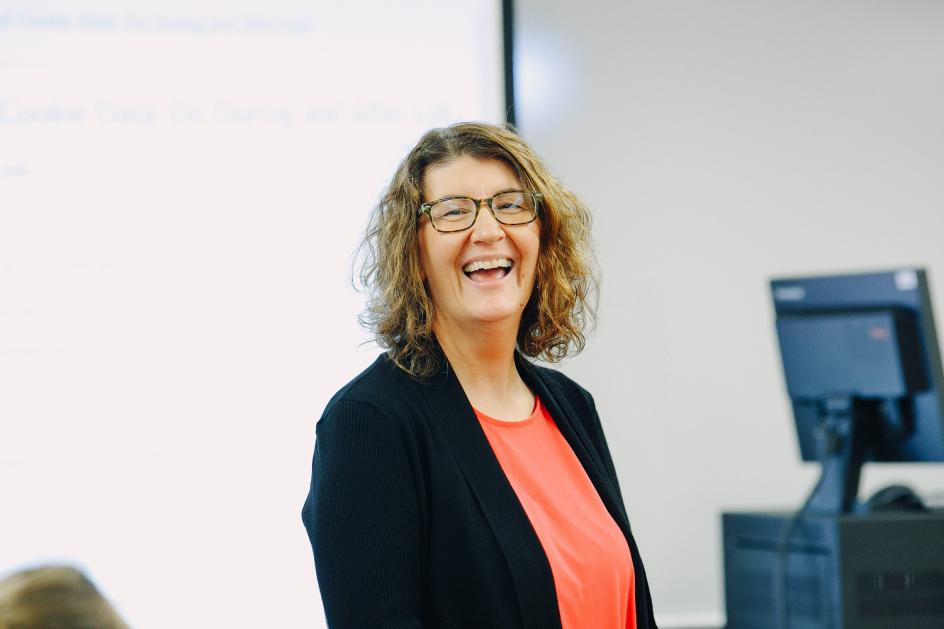
The photo accompanying this story shows Dr. Ginny Gregg in her classroom prior to the COVID-19 pandemic.
Last spring, when COVID-19 forced the closing of campuses across the country, faculty were forced into emergency remote teaching. In the face of ongoing uncertainty and the Heidelberg’s strong desire to fully reopen for in-person classes this fall, there was lots of extra learning going on this summer, and it wasn’t by students.
The majority of Heidelberg professors used the summer months to transition their fall courses to different – and in many cases, multiple – formats. They have gotten more comfortable with technology, re-imagined their syllabi, become more accessible to students, all toward the goal of a successful semester that features mixed modalities of in-person and online courses.
That’s where the Owen Center for Teaching and Learning came in. The center offered its “Learning Online Teaching and Learning” (LOTL) course in the summer, and 80 faculty members took advantage of it. According to Dr. Courtney DeMayo, CTL executive director, the LOTL “taught faculty about online course design and delivery.” Professors also learned about different technology tools, teaching strategies and ways of engaging students in online courses or the online component of hybrid courses.
“It was an amazing course,” said biology professor Dr. Kylee Spencer. “They (the CTL team) gave me so many ideas to use in my own teaching and provided an excellent model of what an interactive online course should be.”
Dr. Carol Dusdieker, professor and director of the School of Music & Theatre, concurs, describing the LOTL course as empowering. “I feel my teaching this fall is more diverse, creative and interactive,” she says. Already, she’s taken advantage of additional online tools as well as more student engagement activities. “For a self-professed ‘tech dinosaur,’ the summer class gave me so many more teaching tools to better engage students.
The faculty members agree that feeling more prepared and not having to deal with “online teaching triage” thrust upon them last March has left them encouraged.
New tools and adaptability
“Last spring, I was just trying to muddle through finishing the material for the semester and to use some new technology,” says psychology professor Dr. Ginny Gregg. Since not all of her students were in environments that were conducive to optimal learning, she had to be extra flexible. This semester, she’s deployed some of the new tools with great success.
“I have mostly hyflex courses, where students come to class on certain days of the week and learn from their residence halls on other days,” she explains. “I have figured out a better way to present information online that students can access before class begins so we can spend more time in the classroom on higher levels of learning (e.g. discussion, synthesis). I also am incorporating new ways of engaging students with technology. Hopefully, they will find it engaging!”
Having additional prep time during the summer – and advance knowledge about which classes will be taught online – has set the faculty members up for success. Having a structure and a routine has opened up opportunities to make learning more interactive, too.
“This summer, totally redesigning our courses from the ground up to be true online courses, I’ve been able to adjust how my teaching is delivered to best fit with an online modality,” Kylee says. She uses discussion boards, group chats and assignments where students record and share videos to engage them more fully in their coursework.
So … how have things gone so far?
There have been a few hiccups, yes. Anxiety has crept in at times with tech issues, time management and just plain missing face-to-face interaction. None of those were unexpected. But overall, all three professors are impressed with how their students have responded so positively.
“Our students have been great,” Carol says, noting that they handled the first week of all online classes during quarantine “with a sense of humor and dedication.”
“While Zoom has its limitations, I feel like our learning community kicked off with enthusiasm.”
This summer, students were given the opportunity to remain at home and complete all of their courses online or return to campus for – in many cases – a mix of online and in-person classes. That way, everyone knew expectations in advance. Ginny believes students appreciated that option.
Despite some early anxiety and worry that online learning won’t provide a social component or they don’t have the time management skills to do well in an online course, students have acclimated extremely well to a world where change has been the rule, not the exception. Interactive learning strategies learned this summer have helped, Kylee says.
“I am impressed with how my students have responded. They’ve done a great job of reaching out to me when they have questions,” she adds.
High hopes for the end game
With two weeks of classes under their belts, all three professors say they hope the campus is able to stay safe for the full semester and that everyone has a productive and successful experience.
“I missed so much being in the classroom,” Ginny says. “I – and I think my students – need to be together in the classroom. It’s so important.”
Carol adds, “My greatest hopes are staying safe and on campus for the full semester, engaging with my students in a new but equally satisfying manner as pre-COVID-19, building a learning community in all my classes that values creativity, collaboration and inclusivity. We are all learners.”
And when all’s said and done? “I hope that when my students look back on this semester, they will be able to say that they learned a tremendous amount and that they were able to do it in a way that kept them safe,” Kylee says.